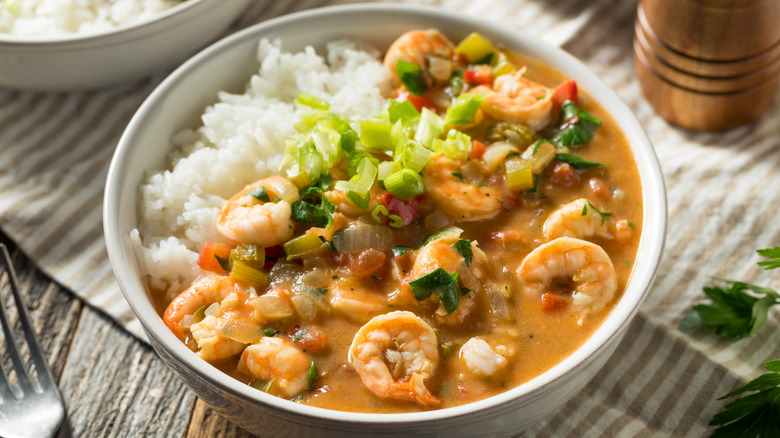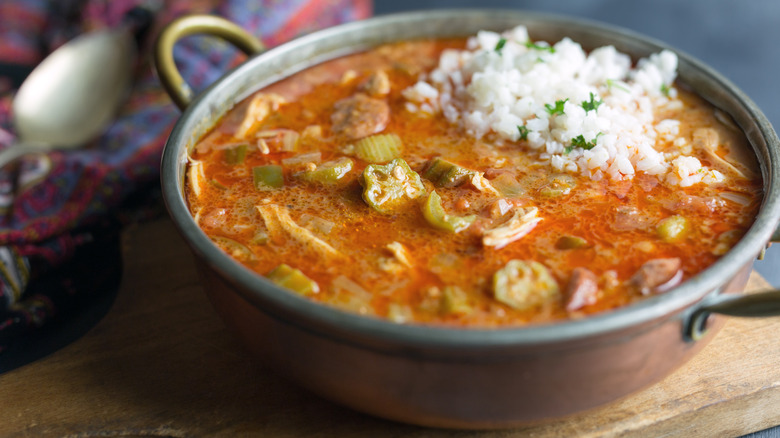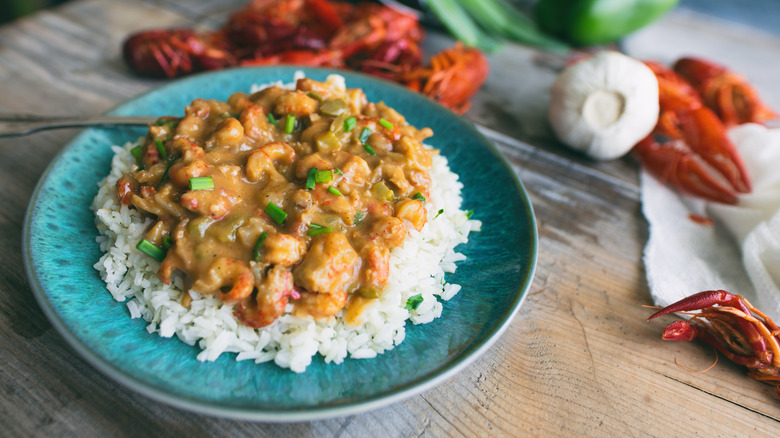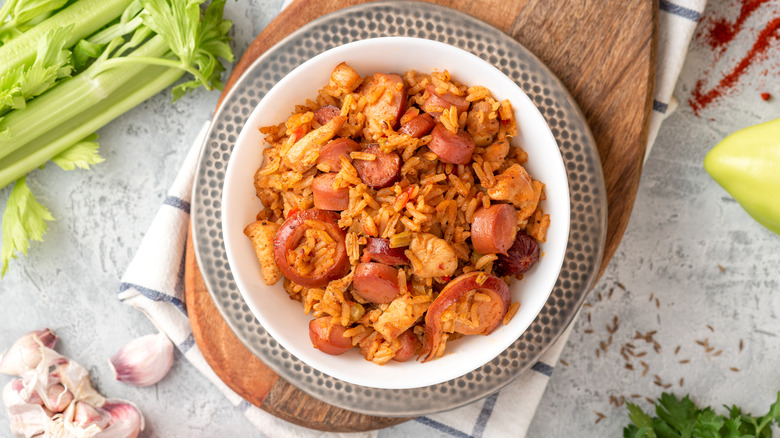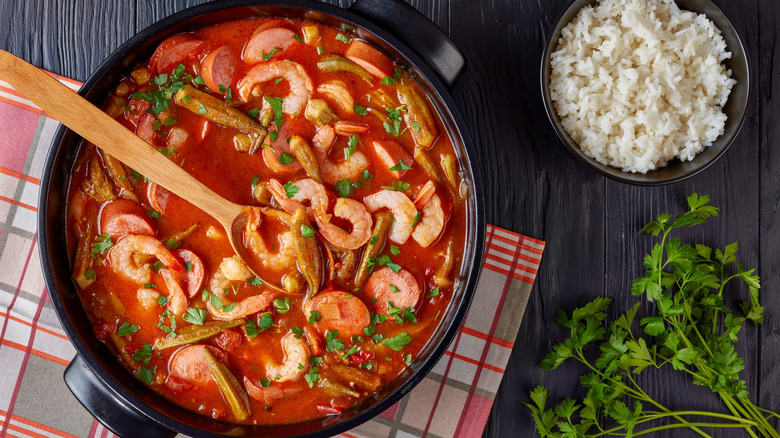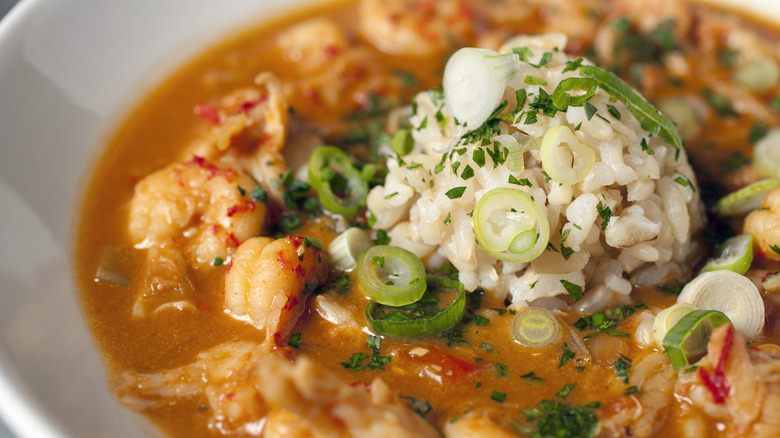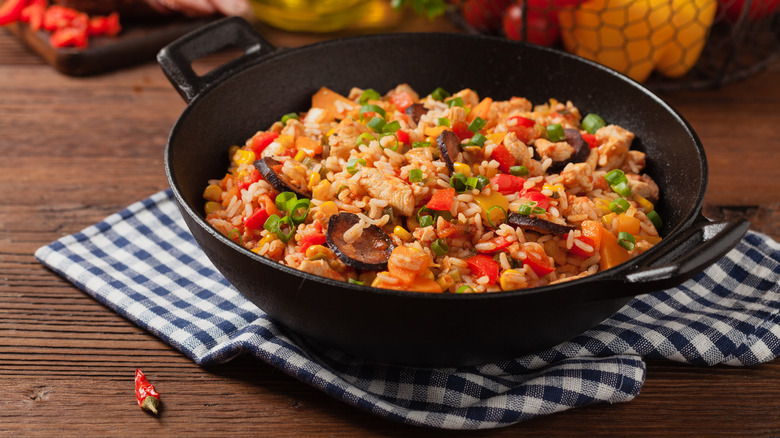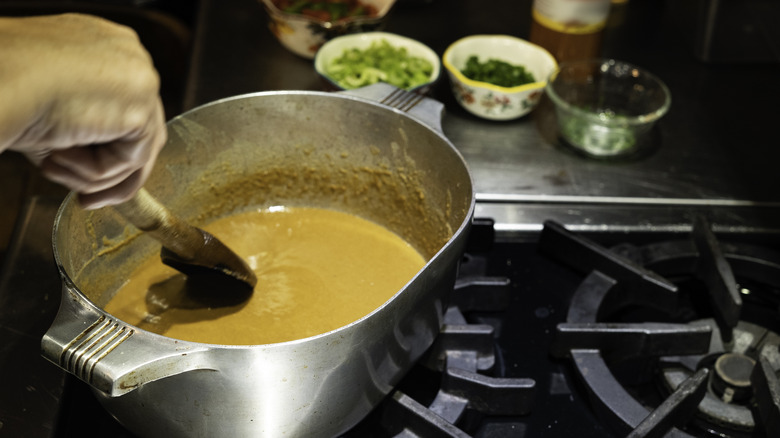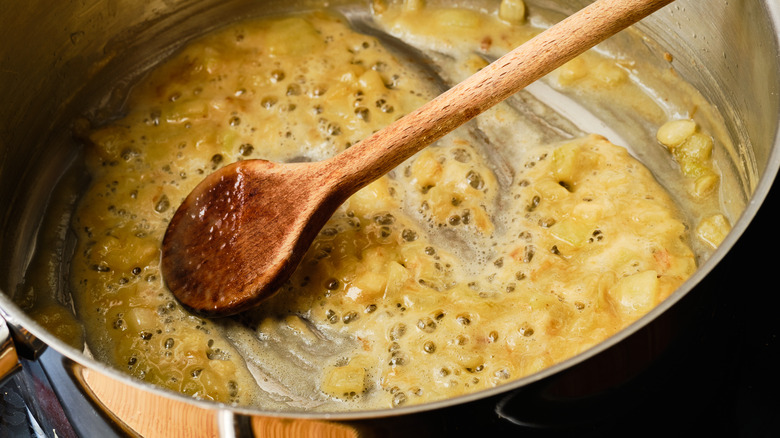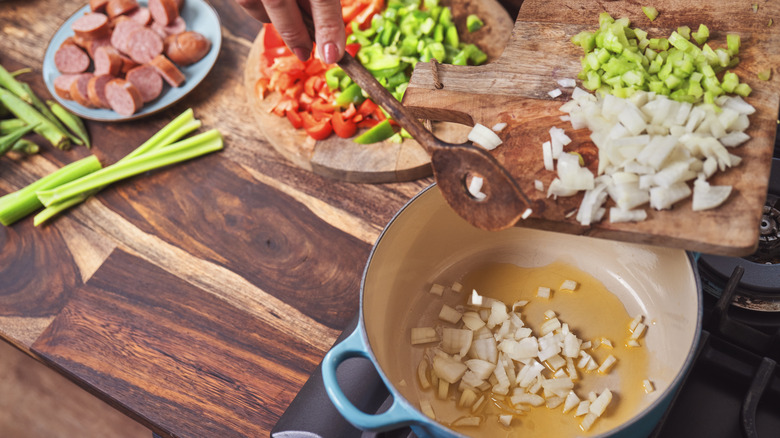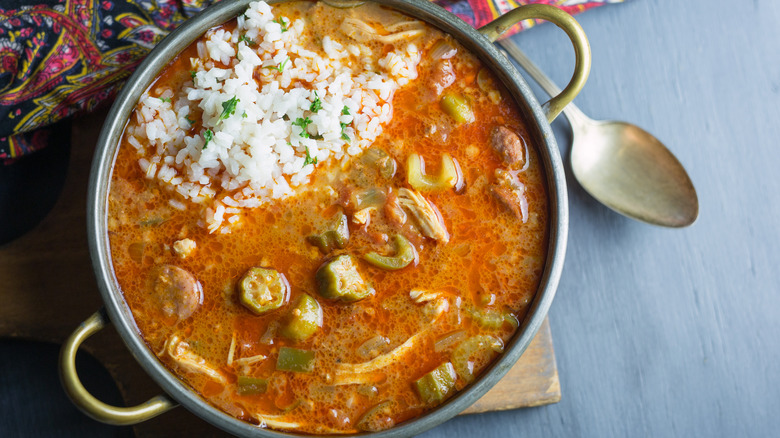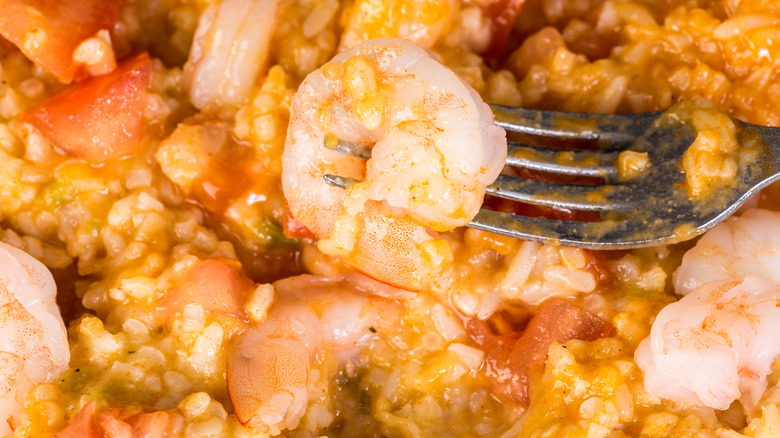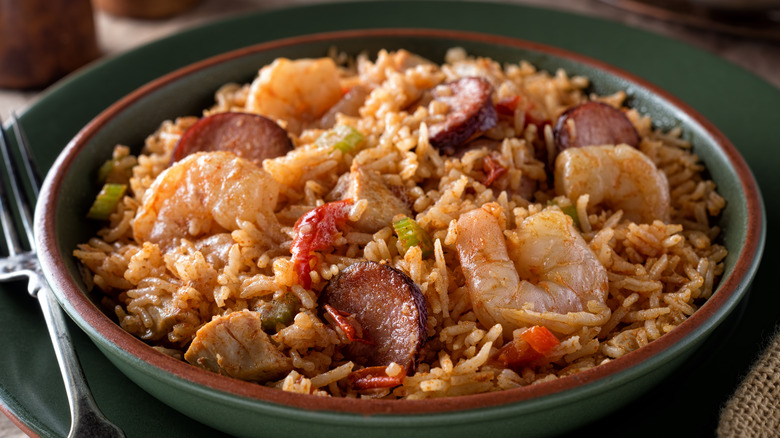What's The Difference Between Gumbo, étouffée, And Jambalaya?
Gumbo, étouffée, and jambalaya are quintessential dishes of Cajun and Creole cuisine, known for their bold flavors, distinct spices, and soulful comfort. Rooted in the diverse heritage of Louisiana, these rice-based dishes epitomize the fusion of African, French, Spanish, and Native American culinary traditions, from the French roux necessary for gumbo and étouffée, to the African influences — first brought to America with the slave trade — found in jambalaya. Beyond their heritage, these dishes share common elements, such as aromatic spices and a combination of meats and seafood, but each boasts its own individuality.
If you ask a Louisiana native, they'll likely know not only what makes each of these dishes distinct, but also the various colors depending on the recipe (such as red jambalaya). Outside of Louisiana, though, coming to an understanding of these staples may take some extra learning, and we're here to help. In a nutshell, gumbo, akin to a stew, relies on a dark roux for its thick, nutty nature; étouffée, on the other hand, features seafood in a silky, flavorful sauce, and; jambalaya, reminiscent of Spanish paella, is a one-pot wonder. Here, we'll get to know the three popular dishes as we explore the differences among them as well as their origins.
What is gumbo?
A quintessential Louisiana dish, gumbo is a rich and hearty soup that uses a combination of meat or seafood, along with vegetables and a roux to thicken the stew. Some think gumbo stemmed from bouillabaisse, the French stew made with fish that likely made its way to Louisiana with French immigrants. While gumbo does have French influences, Serious Eats explains that bouillabaisse is in no way like gumbo, and comparing the two is interesting but wrong. While it's true that gumbo is a stew, it's almost always made with chicken, sausage, or seafood like crab or shrimp, not fish.
Three ingredients are essential to traditional gumbo: Roux, okra, and filé powder. Originally, gumbo was thickened with okra or Creole filé (known as powdered sassafras) in addition to the dark roux. Okra, called gombo in French and ki ngombo in West Africa, is very likely how gumbo got its name and its start. While it's clear that gumbo was influenced by several different cultures, today it's revered as a Louisiana classic, where Creole and Cajun food has found its home. Although gumbo is typically synonymous with Cajun cuisine, there are several variations of the dish. According to The New York Times, there is also Creole gumbo, which can consist of beef, ham, sausage, veal, chicken, crab, or shrimp; a more basic, okra-based gumbo which features okra with shellfish, and; gumbo aux herbes, made with a multitude of vegetables and greens.
What is étouffée?
Étouffée is another classic Louisiana dish, typically made with seafood, such as shrimp or crawfish. The French word étouffée literally means "to smother" in French, and that's exactly how this dish is served — a bed of rice smothered in étouffée, a thick, flavorful, seafood-filled sauce. As classic soulful food from the bayou, étouffée is a blend of many different cultures, including French, Spanish, Caribbean, and African cuisine. Another French-inspired dish common in Louisiana is crawfish bisque, which also requires a light roux to make a rich sauce of pureed ingredients, but étouffée is different, with more texture and typically more spice.
Generally, there aren't as many variations on this dish. You can make it with another kind of seafood, and you could easily use chicken or sausage instead, but it wouldn't quite be as traditional. Two main versions, Creole and Cajun étouffée, come down to a few particular differences. In the Creole recipe, you'll use a light roux, whereas the Cajun dish uses animal fat or oil to thicken the sauce, as well as peppers to bring it more heat.
What is jambalaya?
Jambalaya is a one-pot dish popular in Cajun and Creole cuisine. At the base level, this comfort food combines rice with a mixture of proteins, usually sausage chicken, and sometimes seafood, and vegetables. But jambalaya has a rich culture that has found its way into a versatile, yet classic, dish. While it has its place in both cuisines, especially in today's Louisiana, What's Cooking America explains that the rural, humble nature of the dish is likely of Cajun heritage, rather than Creole culture where wealth was more prevalent.
One possible origin of the word jambalaya may show the true combination of cultural influences: France's word for ham, jambon, and the conjoining à la, with an African word for rice, yaya, come together to form the dish's name — though it's unclear which African language the word yaya may come from. Aside from the inspiration behind the name, Jambalaya might have also been influenced by rice-based one-pot dishes from Africa and Europe, like jollof or paella. Notably, one old and often-forgotten dish from the French region of Provence, combining rice and poultry, is called jambalaia. An iconic dish today, jambalaya is found throughout Louisiana, and also comes as a packaged mix that you can buy at the store (thanks, Zatarain's!) to easily make it at home.
Gumbo is made with a combination of meat and seafood
Sausage is a frequent star in gumbo, with andouille sausage being the most traditional choice; andouille sausage, which can be found in grocery stores, is smoky and spicy. These distinct, strong flavors add depth to the dish, contributing to its complexity. Chicken is another common meat choice, such as in chicken and sausage gumbo variations. Since gumbo simmers in a broth, adding chicken can bring both flavor and richness.
It's also common to find this stew with seafood, be it shrimp, crab, or crawfish, which can add a briny flavor. While there is no fixed recipe for gumbo, several meat and seafood combinations have emerged, varying from region to region and based mostly on preference — for instance, this duck and andouille gumbo, which combines the gamey flavor of duck with the bite of spiced sausage. In general, the point of gumbo is to experiment and create combinations that not only work together but add hearty robustness to the dish.
Étouffée is typically made with seafood
Unlike gumbo or jambalaya, étouffée is made almost exclusively with seafood. While the complex and layered sauce is undeniably the rich base of this dish, the seafood, namely crawfish, is meant to be the star. Also present in traditional, Cajun-style crawfish étouffée is celery, chopped onions, and green bell peppers — the "holy trinity" of Cajun and Creole cooking. However, shrimp étouffée is another common variation, with crab étouffée coming in close, too.
A big reason why this dish relies on seafood rather than chicken or sausage, like in these other dishes, is because of its roots. Cajun-made crawfish étouffée goes back to Breaux Bridges, Louisiana, known as the world's crawfish capital. As Cajun Crawfish tells it, the infamous dish was served in the 1920s at the Hebert Hotel and gained recognition and momentum throughout Louisiana from there. Once the main recipe had been established, it stayed mostly the same as it found its home in Louisiana cuisine.
Jambalaya is made in one pot
Instead of cooking the rice separately, as you do with étouffée and gumbo, all the ingredients for jambalaya go in one pot and cook all together. A good amount of rice, diced tomatoes (if it's Creole-style), and chicken or vegetable broth, along with the holy trinity of green bell peppers, onions, and celery, all go in the pot. Whether you use a pan, work, or skillet is your choice, so long as it fits! This one-pot method is a similar concept to stew, like with gumbo, but the rice being cooked with everything else is imperative. Otherwise, you wind up with something more akin to fried rice or a very weak gumbo.
As it cooks, the rice absorbs the savory liquid and takes on the flavor and aroma of the spices and herbs — usually paprika, cayenne pepper, garlic, bay leaves, oregano, and thyme — and the meat and seafood combo. While jambalaya is highly adaptable, allowing for various ways to put together the ingredients, the main method requires the rice to soak up all that goodness in one pot, simmering until the liquid is nearly gone.
Gumbo requires a dark roux
Creating a roux is a fundamental step in many Cajun and Creole dishes, and it plays a crucial role in gumbo. Unless you're forgoing a roux to use fat, you'll need it to thicken your stew. It's simple to make — a roux is just a mixture of either butter or oil with flour that is stirred into the simmering stew until it thickens. The tricky part is that making a dark roux requires careful attention and patience, as it can easily burn if not stirred continuously. In traditional gumbo recipes, a dark roux is made by mixing the roux for longer until it's dark brown. This imparts the deep, nutty flavor and dark color the dish is known for.
Sometimes, gumbo is known as brown gumbo, as opposed to Creole red gumbo which gets its coloring from tomatoes. A good rule of thumb when making a dark roux for Cajun gumbo is that the darker the brown, the more flavorful the stew will be. With Creole gumbo, you'll still use many of the same ingredients, including the holy trinity of bell peppers, onions, and celery, but the tomatoes will naturally detract from the dark brown the roux brings.
Étouffée uses a light roux
Instead of a darker roux, étouffée is thickened with a light or blonde roux, which doesn't impart as much color or nutty flavor but does allow the seafood and spices to shine through. It still adds some flavor, but most importantly it helps to thicken the sauce, which is necessary for étouffée's creamy texture. With this dish, you want a roux somewhere between a white roux, meant for sauces like bechamel, and a dark roux, which will give an intensity better suited for gumbo. For a blonde roux, you should whisk continuously as it cooks down for around three to five minutes.
While thickening agents like cornstarch could technically get the job done, it's traditional in Creole and Cajun cooking to use a roux not only to thicken a sauce or soup but to instill that distinct flavor that complements the other spices and vegetables. Because this dish doesn't change too much from Creole to Cajun, a light roux is used in both versions.
Jambalaya doesn't require a roux
Unlike gumbo and étouffée, jambalaya doesn't typically use a roux for thickening. If you are using a roux, it's going to be for Cajun-style jambalaya, and can be either dark or light depending on your preference of flavor. When paired with the stock, the roux will still thicken the dish slightly while giving it a subtle, nutty flavor, but as the roux simmers with everything else in the pot, it will pretty much leave once the liquid cooks out. Because of this, a roux is not an essential part of Cajun-style jambalaya, and many recipes won't call for one.
Creole jambalaya doesn't need a roux at all, relying instead on the rice to absorb the flavors from the other ingredients. Because the roux doesn't add a lot of color to jambalaya anyway, the Creole version gets its color from tomatoes — like with most Creole cuisine — and is called red jambalaya. Basically, while you can incorporate a roux if you wish, jambalaya is more of a rice dish than a stew, so it simply isn't needed. You're not looking to achieve thickness as much as you're striving to create flavor.
Gumbo is similar to a stew
Gumbo is often called a stew due to its hearty and comforting nature. While the ingredients that go into gumbo can vary, you can include chicken, sausage, shrimp, okra, onions, celery, and bell peppers (the holy trinity, of course), with an array of seasonings and spices. A gumbo is basically a bunch of these flavorsome ingredients stewed in a big pot of delicious broth.
The real beauty of gumbo is definitely in the broth. Unlike other stews, this dish starts with the roux. After sautéing the onions, celery, and bell peppers in the roux, you add seasonings, and then the broth last — chicken, seafood, or vegetable stock will all work well. Then everything else goes in the pot. When making gumbo, larger pots are often used, probably because of the sheer amount of ingredients that can come together. Simmering times can differ, but gumbo is typically slow-cooked, allowing everything to meld and the flavors to develop, and it's not uncommon for gumbo to simmer for an hour or more to get that rich consistency.
Étouffée is more like a gravy
Étouffée has a rich, silky consistency that's often described as more gravy-like than a traditional stew. While the roux, the stock, the holy trinity of ingredients, and the other spices make it seem similar to a gumbo, it's not at all soupy once it's done. Instead, everything thickens together and poaches the shellfish until a sort of gravy is made. This is poured over rice, much like gumbo, but it smothers the rice rather than puddling around it. After envisioning it, you can see how étouffée is also likened to a curry sauce: Flavorful, thick, slowly simmered, and served over rice.
Whether you're considering Creole or Cajun étouffée, it's still going to contain a thick sauce. The main difference between these two cuisines is, as always, the use of tomatoes. In Creole étouffé, the creamy sauce is usually tomato-based but still involves the same main ingredients. One other notable difference is that the Cajun version usually packs more heat beyond green bell peppers, with seasoning blends incorporating cayenne, paprika, black pepper, garlic powder, and oregano.
Jambalaya is more like paella
Jambalaya is often compared to Spanish paella because of its one-pot cooking method, and that it's a rice, meat, and veggie dish. In any other case, this could be seen as a stretch, but it's actually believed in New Orleans that Spanish settlers brought the culinary technique with them to Louisiana and adapted their paella recipe to the ingredients that were locally available. Traditionally, paella was made with a combination of chicken, pork, or rabbit, with seafood like shrimp or crawfish, plus onions, tomatoes, saffron, garlic, herbs, and rice. A lot like jambalaya so far, right? However, what they left out in New Orleans is the most characteristic part of paella: Saffron. With saffron unavailable, the basic idea behind paella evolved into something else.
Beyond jambalaya's possibly Spanish origins, the other reason it's likened to paella is because of how it's cooked. Whether making the Creole or Cajun dish, nearly all of the broth gets soaked up. This leaves a rice-based dish that's a little wetter than paella, but far more similar to it than a stew.
